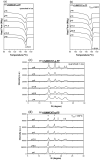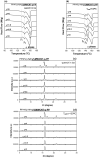Improvement of Water Vapor Permeability in Polypropylene Composite Films by the Synergy of Carbon Nanotubes and β-Nucleating Agents
- PMID: 38006156
- PMCID: PMC10674806
- DOI: 10.3390/polym15224432
Improvement of Water Vapor Permeability in Polypropylene Composite Films by the Synergy of Carbon Nanotubes and β-Nucleating Agents
Abstract
A notable application of polymeric nanocomposites is the design of water vapor permeable (WVP) membranes. "Breathable" membranes can be created by the incorporation of micro/nanofillers, such as CaCO3, that interrupt the continuity of the polymeric phase and when subjected to additional uniaxial or biaxial stretching this process leads to the formation of micro/nanoporous structures. Among the candidate nanofillers, carbon nanotubes (CNTs) have demonstrated excellent intrinsic WVP properties. In this study, chemically modified MWCNTs with oligo olefin-type groups (MWCNT-g-PP) are incorporated by melt processes into a PP matrix; a β-nucleating agent (β-ΝA) is also added. The crystallization behavior of the nanocomposite films is evaluated by differential scanning calorimetry (DSC) and X-ray diffraction (XRD). The WVP performance of the films is assessed via the "wet" cup method. The nanohybrid systems, incorporating both MWCNT-g-PP and β-NA, exhibit enhanced WVP compared to films containing only MWCNT-g-PP or β-NA. This improvement can be attributed to the significant increase in the growth of α-type crystals taking place at the edges of the CNTs. This increased crystal growth exerts a form of stress on the metastable β-phase, thereby expanding the initial microporosity. In parallel, the coexistence of the inherently water vapor-permeable CNTs, further enhances the water vapor permeability reaching a specific water vapor transmission rate (Sp.WVTR) of 5500 μm.g/m2.day in the hybrid composite compared to 1000 μm.g/m2.day in neat PP. Notably, the functionalized MWCNT-g-PP used as nanofiller in the preparation of the "breathable" PP films demonstrated no noteworthy cytotoxicity levels within the low concentration range used, an important factor in terms of sustainability.
Keywords: breathability; carbon nanotubes; nanocomposites; nucleating agent; polypropylene.
Conflict of interest statement
Author Giannis Sotiriou was employed by the company Thrace Polyfilms S.A. and author Stavros Messaritakis was employed by the company Plastika Kritis S.A. The remaining authors declare that the research was conducted in the absence of any commercial or financial relationships that could be construed as a potential conflict of interest.
Figures






References
-
- Chung D.D.L. Applications of composite materials. In: Derby B., editor. Composite Materials: Functional Materials for Modern Technologies. Springer; Manchester, UK: 2004. pp. 1–12.
-
- Wu P.C., Jones G., Shelley C., Woefli B. Novel microporous films and their composites. J. Eng. Fibers Fabr. 2007;2:49–58. doi: 10.1177/155892500700200105. - DOI
-
- Liu S., Jun S.C., Zhang S., Wang F., Yu J., Ding B. Macromolecular Materials and Engineering. Wiley; Hoboken, NJ, USA: 2023. Advancements in Electrospun Nanofibrous Membranes for Improved Waterproofing and Breathability; pp. 2300312–2300337.
-
- Zuiderduin W.C.J., Westzaan C., Huétink J., Gaymans R.J. Toughening of polypropylene with calcium carbonate particles. Polymer. 2003;44:261–275. doi: 10.1016/S0032-3861(02)00769-3. - DOI
-
- Tay J.Y., Lim S., Mah S.K., Tan Y.M. Development of Microporous Breathable Polyethylene Film Using Different Types of Linear Low-Density Polyethylene with Calcium Carbonate as Filler. Solid State Phenom. 2023;349:95–100. doi: 10.4028/p-VGA64b. - DOI
LinkOut - more resources
Full Text Sources
Miscellaneous

